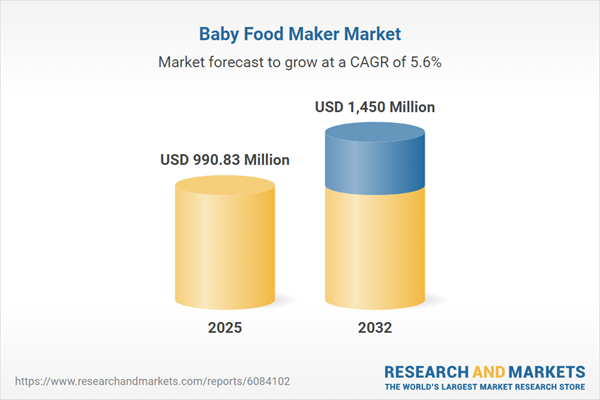Speak directly to the analyst to clarify any post sales queries you may have.
The baby food maker market is evolving quickly, shaped by shifting consumer needs, advances in technology, and new approaches across both distribution and production. Senior leaders must navigate this transformation with agile strategies to maintain competitiveness, sustainability, and growth.
Market Snapshot: Baby Food Maker Market Size & Growth Outlook
The baby food maker market expanded from USD 936.98 million in 2024 to USD 990.83 million in 2025 and is anticipated to grow at a CAGR of 5.62%, reaching an estimated USD 1.45 billion by 2032. This sustained momentum is driven by heightened parental focus on safety and nutritional value, coupled with ongoing innovation in supply chain management and packaging. Digital engagement and the rapid uptake of personalized solutions are further influencing product and service differentiation within this sector.
Scope & Segmentation: Strategic Insights into Market Structure
- Product Types: Includes cereal-based (oatmeal and rice cereals), dairy-based, fruit-based (such as apple, banana, and mixed fruit), meat-based, and vegetable-based options to address varied dietary needs and consumer demand for diverse nutritional profiles.
- Distribution Channels: Encompasses convenience stores, various online retail platforms including e-commerce, manufacturer websites and mobile apps, alongside specialty stores and supermarkets/hypermarkets, ensuring broad market penetration and access.
- Packaging Types: Features formats such as jars (subcategories: less than 100g, 100–200g, over 200g), pouches, powders, and trays, supporting user convenience, portability, and shelf-life requirements.
- End Users: Targets infants in the 0–6 month bracket (split into 0–3 and 4–6 months), 7–12 months (7–9 and 10–12 months), and toddlers aged 13–24 months (13–18 and 19–24 months), reflecting age-specific nutrition and feeding preferences.
- Nature Categories: Covers both conventional and organic product lines, enabling brands to meet distinct purchasing preferences, particularly among health-conscious and environmentally aware caregivers.
- Geographic Coverage: Addresses the Americas (North America, Latin America), Europe, Middle East & Africa (encompassing Western, Central, and emerging markets), and Asia-Pacific with detailed subregional insights to capture growth dynamics and local variances.
- Leading Companies: Profiles key players such as Nestlé S.A., Danone S.A., Abbott Laboratories, Reckitt Benckiser Group plc, Arla Foods amba, The Hain Celestial Group, Inc., Hero Group Holding AG, Biostime International Holdings Limited, China Mengniu Dairy Company Limited, and Perrigo Company plc.
Key Takeaways: Strategic Direction for Decision-Makers
- Clean labeling and full ingredient traceability have become core purchase drivers for parents and caregivers, reinforcing the need for transparency throughout the value chain.
- Manufacturers now leverage digital platforms for direct customer communication, education, and simplified ordering, moving engagement beyond brick-and-mortar channels into personalized digital ecosystems.
- Eco-friendly packaging innovation and transparency in sourcing, including the use of technologies like blockchain, are gaining reputational value and influencing consumer choices.
- Personalized product development, incorporating scientific, technological, and data-analytics-driven insights, is essential to meet evolving caregiver demand for nutrition customized to age and dietary requirements.
- Strong brand loyalty increasingly depends on shared values and trust, especially among millennial and Gen Z parent segments who prioritize alignment between ethics and product quality.
- Collaborations across the supply network—including partnerships among producers, agricultural co-ops, and technology firms—are accelerating differentiation, enhancing supply chain resilience, and enabling faster adaptation to emerging trends.
Tariff Impact on Supply Chains and Sourcing Models
Recent U.S. tariff changes are reshaping procurement strategies and operational priorities across the baby food maker market. Companies are responding by diversifying sourcing, strengthening regional supply networks, and investing in ingredient optimization to counteract rising input costs. Industry coalitions play a core role in advocacy, policy engagement, and proactive risk management as manufacturers adapt to unpredictable trade environments.
Methodology & Data Sources
This analysis integrates primary research, including interviews with senior executives and conversations with supply chain and regulatory professionals. Data from trade journals, government publications, and corporate reports augment findings, all subjected to triangulation and expert review to ensure accuracy and depth.
Why This Report Matters: Actionable Intelligence for Leadership
- Enables executives to make informed investment, product strategy, and go-to-market choices, leveraging a complete view of both global and regional dynamics.
- Clarifies disruptive shifts in consumer behavior, supply pressures, and technology adoption—supporting agile strategic planning and risk mitigation in a complex market.
- Provides evidence-based insights to drive sustainable initiatives, regulatory alignment, and competitive positioning against evolving benchmarks.
Conclusion
With holistic insights into trends and drivers shaping the sector, decision-makers can optimize strategy and foster resilience. Adaptability, digital transformation, and a focus on sustainability will support lasting success in the baby food maker market.
Table of Contents
3. Executive Summary
4. Market Overview
7. Cumulative Impact of Artificial Intelligence 2025
Companies Mentioned
The companies profiled in this Baby Food Maker market report include:- Nestlé S.A.
- Danone S.A.
- Abbott Laboratories
- Reckitt Benckiser Group plc
- Arla Foods amba
- The Hain Celestial Group, Inc.
- Hero Group Holding AG
- Biostime International Holdings Limited
- China Mengniu Dairy Company Limited
- Perrigo Company plc
Table Information
| Report Attribute | Details |
|---|---|
| No. of Pages | 190 |
| Published | October 2025 |
| Forecast Period | 2025 - 2032 |
| Estimated Market Value ( USD | $ 990.83 Million |
| Forecasted Market Value ( USD | $ 1450 Million |
| Compound Annual Growth Rate | 5.6% |
| Regions Covered | Global |
| No. of Companies Mentioned | 11 |









